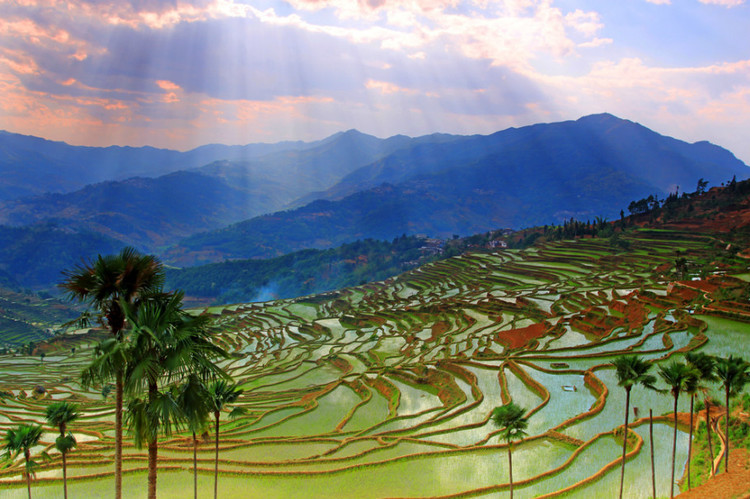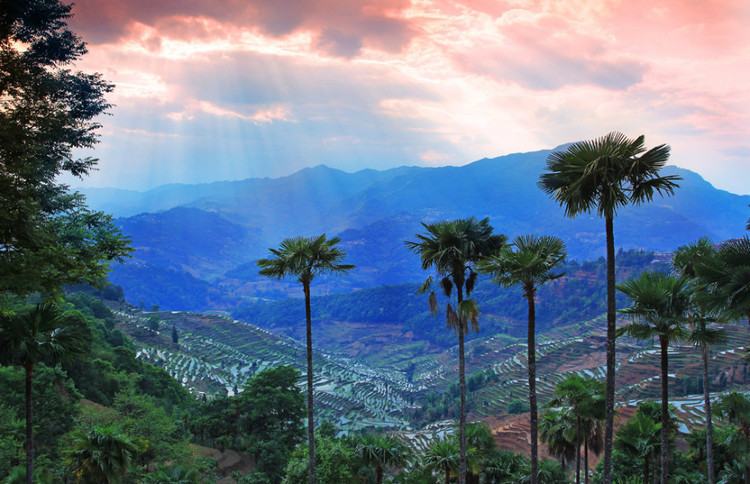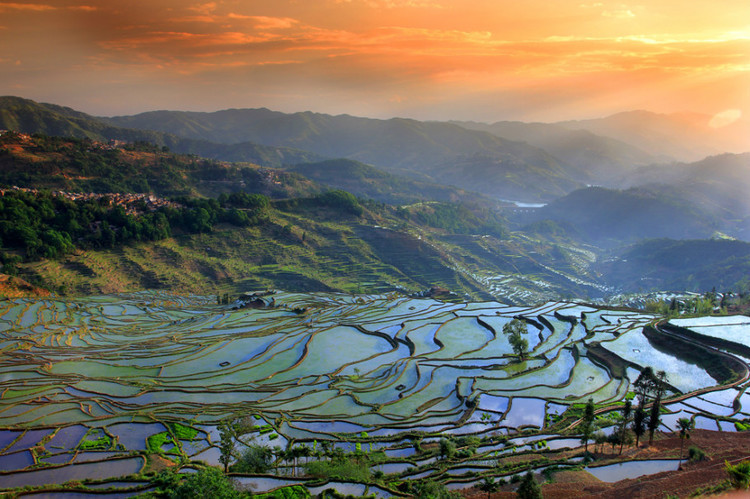
Tasa Rice Terraces in Honghe County, Honghe
Overview
The Tasa Rice Terraces (他撒梯田, Tāsà Tītián) are located in Tasa Village (他撒村, Tāsà Cūn), part of Jiayin Township (甲寅乡, Jiǎyín Xiāng) in Honghe County (红河县, Hónghé Xiàn), known as the “Home of Palms.” In Jiayin, lush forests tower above every village, with dense palm trees dominating the landscape. The villages are characterized by mushroom-shaped houses nestled beneath the trees, while the lower levels showcase cascading rice terraces. Standing at the Shier Longquan Viewing Point (十二龙泉观景点, Shí’èr Lóngquán Guānjǐngdiǎn), one can gaze down at the vast expanse of Tasa Rice Terraces, which cover over 2,000 acres. These terraces are intricately carved into the mountainsides, forming a U-shaped valley that accentuates their grandeur, enhanced by the backdrop of clouds, palm trees, reservoirs, and forests.
Location
The Tasa Rice Terraces are situated in Tasa Village (他撒村, Tāsà Cūn), Honghe County (红河县, Hónghé Xiàn), Yunnan Province (云南省, Yúnnán Shěng). The village spans 10 square kilometers at an elevation of 1,950 meters, with an average annual temperature of 14°C and annual rainfall of 1,310 millimeters, making it suitable for cultivating rice, corn, soybeans, potatoes, and cassava. The village has 1,275 households and a population of 6,384, predominantly engaged in agriculture.
Scenic Beauty
Among the many rice terraces in Honghe County, Tasa Rice Terraces are considered the most beautiful. Covering over 2,000 acres, these terraces create a vibrant tapestry of colors and shapes as they stretch across the landscape. The terraces, varying in size and height, come together to form intricate lines, creating a diverse and picturesque scene. When illuminated by the setting sun, the cascading layers of terraces glow with a golden hue, transforming the area into a breathtaking spectacle.
At an altitude of over 1,800 meters, the Tasa Rice Terraces consist of more than 5,000 steps, providing sustenance for the over 10,000 Hani people (哈尼族, Hānī Zú) in Jiayin. During the autumn harvest, the golden rice fields shimmer under the sunlight, showcasing the joy of the Hani people as they celebrate their bountiful harvest.
Traditional Practices
Rice-fish farming is a traditional livelihood for the Hani people and exemplifies their sustainable use of local resources. After planting rice, the Hani people introduce fish fry into the paddies, where they help control pests and weeds. The fish waste also enriches the soil, promoting healthy rice growth. By the time the rice is harvested, the fish have grown as well, resulting in a “dual harvest” of rice and fish. This practice maximizes the use of terrace resources while boosting the economic returns for the Hani community.
As the autumn air turns crisp and the clouds drift overhead, the golden rice plants cover the terraces, creating a stunning landscape. For the Hani farmers, witnessing the fruits of their labor during harvest season is the most exhilarating time of the year, representing a mutual benefit between them and the terraces.
On June 22 of this year, the Yunnan Hani Rice Terraces were officially listed as a UNESCO World Heritage Site.
Photography Highlights
When visiting Tasa Village (他撒村, Tāsà Cūn) in Honghe, one cannot help but think of the Twelve Dragon Springs (十二龙泉, Shí’èr Lóngquán), Baishi Mountain (白石山, Báishí Shān), and the cherry blossom palm views at Tasa Rice Terraces. The stunning beauty is interconnected, creating a captivating atmosphere.
Currently, the rice plants in Tasa are turning golden. The rich grains fill the fields, bending under their own weight, and the sweet scent of harvest fills the air. On August 28, photographs were taken to capture the beautiful landscape of the Tasa Rice Terraces during the harvest season.
The Cherry Blossom Palm Rice Terrace Scenic Area (樱花棕榈秀梯田景点, Yīnghuā Zōnglǚ Xiù Tītián Jǐngdiǎn) is located 5 kilometers from the Jiayin Township government. The terraces feature gentle lines adorned with cherry blossoms and palm trees, creating a stunning view as the golden sunlight breaks through the clouds and bathes the terraces. This spot is perfect for sunset photography.
Best Photography Seasons
- Optimal Season: Winter
- Best Time for Photos: 5:30 PM to 7:30 PM
How to Get There
To reach Tasa Rice Terraces in Honghe County, take a bus from Kunming to Honghe County. Buses are available daily, and the journey typically takes around 6-7 hours. Upon arrival in Honghe, you can find local transportation options to Tasa Village.
Local Transportation
- Buses: From the Honghe bus station, local buses run regularly to Tasa Village.
- Taxis: Taxis can also be hired for direct access to the terraces.
Travel Tips
- Photography Gear: Bring a good camera or smartphone to capture the stunning landscapes, especially during the golden hour of sunset.
- Local Cuisine: Don’t miss out on local specialties such as Hani-style grilled fish and rice dishes, which provide a taste of the region’s culinary heritage.
- Accommodation: Consider booking a guesthouse or hotel in Jiayin for easy access to the terraces and a comfortable stay.
- Best Time to Visit: Autumn is particularly beautiful due to the harvest season, but visiting in winter also provides unique photographic opportunities. Spring showcases lush greenery, while summer is vibrant and lively.
In conclusion, the Tasa Rice Terraces in Honghe County are a must-visit destination for nature lovers, photographers, and anyone interested in experiencing the rich culture of the Hani people. The stunning landscapes, traditional farming practices, and picturesque views create an unforgettable experience.





Location:














